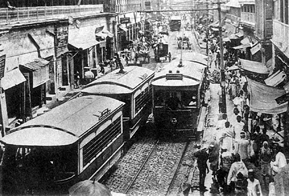Calcutta Tramways
Calcutta Tramways was designed to be developed as the first organised mass transport. As a trading and business centre in the service of British investors and businessmen the town of Calcutta was developing fast. Even then it was mainly a town of palanquins, phaetons and other animal driven private transports. The Calcutta Corporation, authorised by Act IX of 1867 and with financial assistance from the Government of Bengal, took the initiative to develop mass transport that resulted in the introduction of Calcutta Tramways. The first tramcar rolled out on 24 February 1873 on the streets of Calcutta, with horse driven coaches running between Sealdah and Armenian Ghat via Bowbazar and Dalhousie Square.

The Corporation’s endeavour, however, did not prove economically viable and the Corporation consequently entered into an agreement on 2 October 1879 with three industrial magnates of England: Robinson Soutter, Alfred Parrsh and Dilwyn Parriih. They received the right to invest capital for constructing and maintaining the tramways in the city. The Calcutta Tramways Act of 1880 gave sanction to this agreement. Registered in London, the Calcutta Tramways Company came into existence in the same year.
The Bengal Government and the Calcutta Corporation gave permission to the Company to run tramcars from 1 November 1880. It was decided that trams would ply between Sealdah Railway Station to Chandpal Ghat via Dalhousie Square.
But, since the tramlines could not be laid by November, for the first few days' trams ran from Sealdah to Dalhousie Square. However, by 1884, eight lines were opened to traffic; Sealdah, Chitpore and Chowringhee lines in 1881, Dharmatallah, Strand Road, Shambazar, Kidderpore in 1882, and Wellesley line in 1884. Steam traction was used for a very short period of time in the Kidderpore and Chowringhee sections between 1882 and 1883 and elsewhere horses drew trams.
In 1896, Messrs Kilburn & Co sought the permission of the Calcutta Corporation for the introduction of electric propulsion in the tramcars. In 1899 the proposal was accepted and by 1902 the electrification of the Calcutta tramways was completed. In the same year, the first electric tramcar was introduced in the Kidderpore section.
The completion of the electrification process accounted for the phenomenal growth of the Calcutta tramways. The Calcutta Tramways (Howrah) Act 1905 paved the way for the introduction of the tramways in Howrah. In 1926, the Calcutta Tramways Company claimed the credit of running the first bus in Calcutta, a project that was later given up. Incidentally by 1943, Calcutta had a complete network of tram service from Tollygunge to Galiff Street and Sibpur (in Howrah) to Rajabazar.
In the years following 1920, the Calcutta tramway workers were greatly involved in trade union activities. In 1920, the Calcutta tramway men formed their first association, Calcutta Tramways Employees Union. In 1927, the Calcutta Tramways Employees Union was reorganised under a new name Calcutta Tramways Workers Union. Bhupendranath Dutta and Phanindra Kumar Sanyal were the founder president and secretary respectively of this union. Later on communist leaders like Somnath Lahiri, Bankim Mukherjee and Mohammad Ismail were associated with this union. The tramway workers under the influence of the leftist trade union leaders were involved in militant movements against the alien management in 1939, 1945 and 1947. Significantly, during the communal holocaust in Calcutta, the Calcutta tram workers played a glorious role to maintain Hindu-Muslim harmony in the city.
After the independence of India, negotiations started between the Company and the West Bengal Government on issues related to management and ownership. Subsequently, the Calcutta Tramways Act of 1957 empowered the government to acquire the right to purchase the undertaking after twenty years and finally the government nationalised the Calcutta Tramways Company by the Act of 1967. [Raj Sekhar Basu]
Bibliography Sisir Mitra, A public Facility, Its management and the Workers: A Case Study of the Calcutta Tramways, Its Growth and Decay, 1939-1975, New Delhi, 1980, Siddhartha Guha Ray, 'History of the Working Class in the Calcutta Tramways Company, 1920 -1967', Unpublished Ph D Dissertation, University of Calcutta, 1988.
